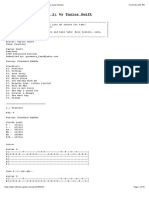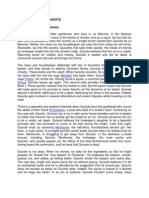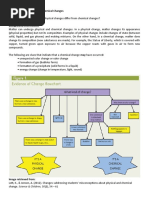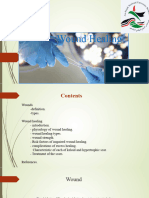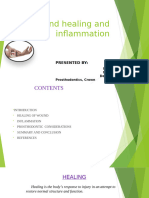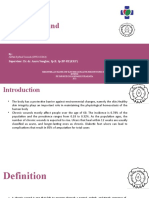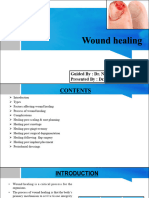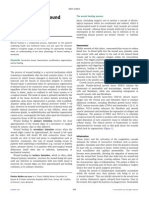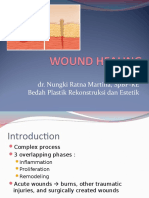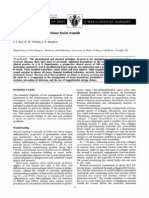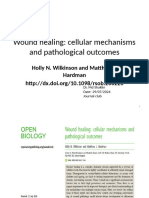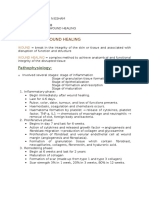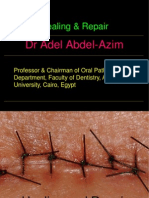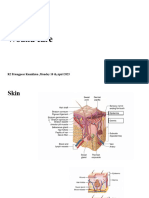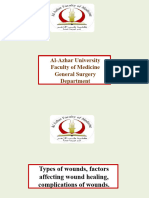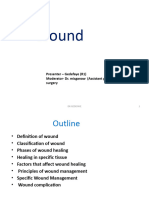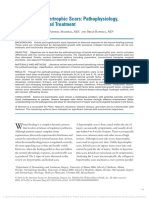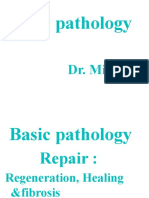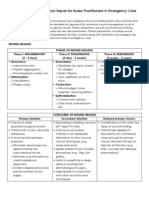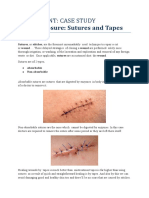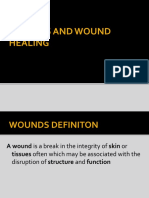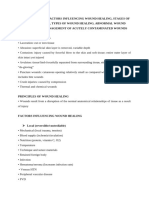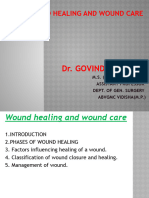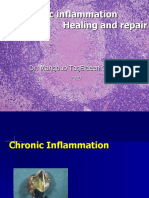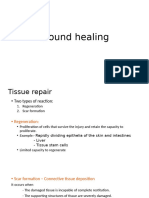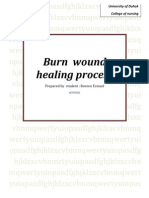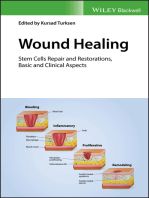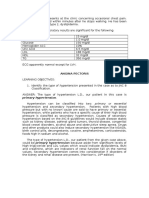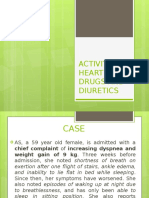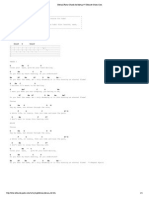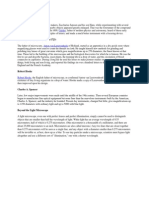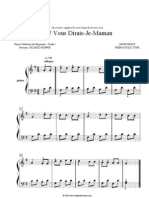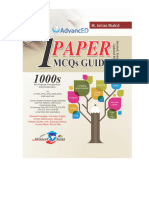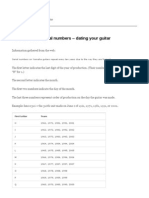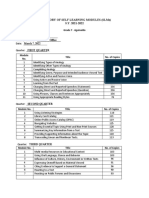(SURGERY SGD) Wound Healing
(SURGERY SGD) Wound Healing
Uploaded by
Paulene RiveraCopyright:
Available Formats
(SURGERY SGD) Wound Healing
(SURGERY SGD) Wound Healing
Uploaded by
Paulene RiveraOriginal Description:
Original Title
Copyright
Available Formats
Share this document
Did you find this document useful?
Is this content inappropriate?
Copyright:
Available Formats
(SURGERY SGD) Wound Healing
(SURGERY SGD) Wound Healing
Uploaded by
Paulene RiveraCopyright:
Available Formats
Jean Paulene W.
Rivera
September 19, 2016
2D
BASIC SURGERY SGD
WOUND HEALING
Case #1
A 45 years old male patient came to your clinic complaining of a 5cm
lacerated wound to his right elbow after being hit by bamboo stick two
hours prior to consult. Full range of motion on right elbow, no
paresthesia noted. As the attending physician, your immediate plan
was to give anti-tetanus vaccination.
1. What is the management of acute wounds?
Treatment of acute wounds depends upon its location and severity.
General wound care may include the following:
Controlling the bleeding Identify the source of bleeding
and applying pressure (if applicable) to make it stop.
Cleansing the wound General soap and water may be
used on minor acute wounds. Saline solutions may be used on
larger, deeper or more complex wounds.
Debridement If necessary, clear the wound of any debris, dirt
or objects. A health care professional may remove dead tissue
from the wound.
Dressing and/or closing the wound Some wounds may
require a health care professional to apply staples, skin
adhesive, sterile strips or stitches to bring the wound edges
together to close. Wounds may be left open to air or covered
with dressings depending upon their location and severity.
Antibiotics and other medicines In some cases,
antibiotics may be prescribed to thwart off infection. This is
typical in wounds with a high risk of developing infection, as in
those contaminated with debris. Medications for pain, swelling
and other wound specific treatments (such as a tetanus shot)
may also be recommended.
2. Discuss the phases of wound healing.
The 3 phases of wound healing are:
1. Hemostasis and Inflammation
2. Proliferation
3. Maturation and Remodeling
HEMOSTASIS
Hemostasis - precedes and initiates inflammation with the
ensuing release of chemotactic factors from the wound site.
Wounds, which disrupt tissue integrity, would lead to collagen
synthesis.
In early phase of wound healing:
o PMNs release proteases such as collagenases, which
participate in matrix and ground sub- stance degradation
(these cells do not appear to play a role in collagen
deposition or acquisition of mechanical wound strength;
neutrophils delay epithelial closure of wounds)
Macrophages are the second population of inflammatory cells
that invades the wound; they participate in wound dbridement
via phagocytosis and contribute to microbial stasis via oxygen
radical and nitric oxide synthesis
o Most pivotal function: activation and recruitment of other
cells via mediators: cytokines and growth factors, as well
as directly by cell-cell interaction and intercellular adhesion
molecules (ICAM).
o Regulate cell proliferation, matrix synthesis, and
angiogenesis through the following mediators: TGF-,
vascular endothelial growth factor (VEGF), insulin-like
growth factor (IGF), epithelial growth factor (EGF)
o Regulate angiogenesis
remodeling
and
matrix
deposition
and
T
lymphocytes
comprise
another
population
of
inflammatory/immune cells that routinely invades the wound;
peak at about 1 week post-injury and truly bridge the transition
from the inflammatory to the proliferative phase of healing.
o Their role in wound healing is not fully defined. Hypothesis
is that T lymphocytes play an active role in the modulation
of the wound environment.
o Lymphocytes also exert a down regulating effect on
fibroblast collagen synthesis by cell-associated interferon
(IFN)-, TNF-, and IL-1.
PROLIFERATION
th
Second phase of wound healing and spans from the 4
th
to 12 day
Tissue continuity is re-established
Fibroblasts and endothelial cells last cell population to
invade the wound
PDGF strongest chemotactic factor for fibroblasts
(mediated by cytokines and growth factors) to carry out
their function of matrix synthesis and remodeling
Wound fibroblasts synthesize more collagen than
non- wound fibroblast, by proliferating less and
actively carrying out matrix contraction
Lactate a potent regulator of collagen synthesis through a
mechanism involving adenosine diphosphate (ADP)ribosylation
Endothelial cells participate in angiogenesis
o Migrate from intact venules to close wound
o Migration, replication and new capillary tubule
formation is via:
TNF-
TGF-
VEGF
MATURATION AND REMODELING
Begins during the fibroblastic phase
Characterized by a reorganization of previously synthesized
collagen
Matrix metalloproteinase (MMP) breaks down collagen
Net wound collagen balance between collagenolysis and
collagen synthesis
Pattern for the deposition of matrix in the wound:
Early matrix scaffolding fibronectin and
collagen type III
Middle
matrix
scaffoldingGAGs
and
proteoglycans
Final matrixcollagen type I
After weeks of injury, collagen amount in the wounds
reaches a plateau but tensile strength increases
Fibril formation and cross-linking result from:
Decreased collagen solubility
Increased strength
Increased resistant to enzymatic degradation
Fibrillin a glycoprotein secreted by fibroblast, essential for
the formation of elastic fibers in connective tissue
Scar remodeling continues for 6-12 months post injury
resulting in a mature, avascular and acellular scar
Mechanical strength of the scar never achieves that of
uninjured tissue
3. What are the factors that affect wound healing?
Advanced Age
Delayed and impaired wound healing (1.9 days)
Noncollagenous protein accumulation at wounded
sites is decreased with aging, impairing
mechanical properties of scarring
Hypoxia, Anemia and Hypoperfusion
o Collagen synthesis requires oxygen as a cofactor,
specifically for the hydroxylation steps
o Mild to moderate normovolemic anemia does
not appear to adversely affect wound oxygen
tension and collagen synthesis unless hematocrit
falls between 15%
Steroids and Chemotherapeutic Drugs
o Reduce collagen synthesis and wound strength
o Steroids inhibit the inflammatory phase of
wound healing and release of lysosomal enzyme,
epithelialization, contraction and contribute to
increase rates of wound infection
o Chemotherapeutic antimetabolite drugs inhibit
early cell proliferation and wound DNA and protein
synthesis
Metabolic Disorders
o Diabetes Mellitus
affects wound healing by:increased
rates of wound infection and failure
reduce inflammation, angiogenesis and
collagen synthesis
defects in granulocyte function, capillary
growth and fibroblast proliferation
Type 1 diabetics decrease wound collagen
accumulation, independent of degree of
glycemic control
Type 2 diabetics no effect on collagen
accretion
o Uremia
Decreased wound collagen synthesis and
breaking strength
o Obesity
have higher risk for wound dehiscence,
surgical site infections, incisional hernias,
seromas, hematoma and fat necrosis
Nutrition
o Induction of energy-deficient states that by
providing only 50% of normal caloric requirement
leads to:
Decreased granulation tissue formation
Matrix protein deposition
Malnutrition correlates clinically with enhanced
rate of wound
complications and increased
wound failure post-operation, reflecting:
Impaired healing response
Reduced cell mediated immunity
Reduced phagocytosis
Reduced intracellular killing of bacteria by
macrophages and neutrophils
Arginine most active in terms of enhancing
wound fibroplasias. In healthy individuals,
arginine supplementation enhanced collagen and
protein deposition at the wound site
Vitamin C - deficiency (Scurvy) leads to failure in
collagen synthesis and cross linking, Increase in
severe wound infection.
Vitamin A
o Increases
inflammatory
increase
the
lability
membranes.
response
and
of
lysosomal
o Increase collagen production and epidermal
growth factor receptors.
o Restores wound healing properties impaired
by
diabetes,
tumor
formation,
cyclophosphamide and radiation
o Trace elements - cofactor or part of an enzyme
that is essential for homeostasis and wound
healing
o Zinc deficiency leads to
Decreased fibroblast proliferation
Decreased collagen synthesis
Impaired overall wound strength
Delayed epithelialization
Infection
o Lead to disfiguring, unsightly or delayed closures
Case #2
A 60 years old female, diabetic patient was referred to you due to a
non-healing wound at the left plantar area. On physical examination a
4x4cm, erythematous, swollen lesion with foul smelling yellowish
discharge was noted on her plantar area.
1. What is the management of chronic wounds?
Assess the entire patient
Characterize the wound - (1) size and depth of involvement
and the extent of undermining, (2) the appearance of the
wound surfaceis it necrotic or viable, (3) amount and
characteristic(s) of wound exudate, and (4) status of the
periwound tissues (eg, pigmented, scarred, atrophic,
cellulitic).
Ensure adequate oxygenation
Ensure adequate nutrition
Treat underlying infection
Remove foreign bodies
Manage pain
Ischemial Arterial Ulcers - revascularization or re-establish
blood adequate blood supply progress to healing
Venous Stasis Ulcers - treatment is compression therapy,
via rigid or flexible means. Most common is rigid: zinc
oxide-impregnated, non- elastic bandage.
Diabetic Wounds - treatment should address the possible
presence of Osteomyelitis and employ antibiotics that
achieve adequate levels both in soft tissue and bone
Decubitus or Pressure Ulcers - treatment comprises
debridement of all necrotic tissue, maintenance of a
favourable moist wound environment that will facilitate:
Healing , relief of pressure and addressing host issues:
nutritional, metabolic and circulatory status
Peritoneal Scarring - Major strategies for adhesion
prevention or reduction: (1) Trauma is minimized within
the peritoneum by careful tissue handling, avoiding
desiccation and ischemia, and spare use of cautery, laser
and retractors (2) Introduction of barrier membranes and
gels which separate and create barriers between
damaged mesothelial surfaces, allowing for adhesion-free
healing
2. Discuss the factors for the development of chronic wounds.
Repeated trauma
Poor perfusion or oxygenation
Excessive inflammation
Unresponsiveness to normal regulatory signals
Failure of norma lgrowth factor synthesis
Over expressed protease activity or failure of antiprotease mechanism
You might also like
- Wound HealingDocument59 pagesWound HealingLavanya Kalapala50% (4)
- Fearless Chords (Ver 2) by Taylor Swift Tabs at Ultimate Guitar ArchiveDocument35 pagesFearless Chords (Ver 2) by Taylor Swift Tabs at Ultimate Guitar ArchivePaulene RiveraNo ratings yet
- Utopia SummaryDocument6 pagesUtopia SummaryPaulene Rivera100% (1)
- Summary of Don QuixoteDocument6 pagesSummary of Don QuixotePaulene Rivera100% (1)
- Physical and Chemical Change Virtual Lab ST Lesson Santellano Victoria ADocument3 pagesPhysical and Chemical Change Virtual Lab ST Lesson Santellano Victoria Aapi-255434272No ratings yet
- Wound Healing & Wound Care: Souvik Adhikari Postdoctoral TraineeDocument55 pagesWound Healing & Wound Care: Souvik Adhikari Postdoctoral TraineeClaudio Luis VenturiniNo ratings yet
- 7. WoundsDocument44 pages7. Woundsapolloniwagaba02No ratings yet
- Chap-1a Wound HealingDocument60 pagesChap-1a Wound HealingAlex HaileyesusNo ratings yet
- Hatim NewDocument50 pagesHatim NewJaser YaminNo ratings yet
- Wound Healing and InflammationDocument90 pagesWound Healing and InflammationAnubhav gargNo ratings yet
- Wound Healing and Its PatologyDocument18 pagesWound Healing and Its PatologyAnggie MutmainnahNo ratings yet
- Referat - CHRONIC WOUNDDocument19 pagesReferat - CHRONIC WOUNDAfifah Syifaul UmmahNo ratings yet
- Wound Healing1Document8 pagesWound Healing1muralidhar_mettaNo ratings yet
- Wound HealingDocument46 pagesWound HealingSahin mollickNo ratings yet
- Balsa 2015Document17 pagesBalsa 2015Pipe VodNo ratings yet
- 1 7 10 Wound HealingDocument3 pages1 7 10 Wound Healingkep1313No ratings yet
- GROUP6Document22 pagesGROUP6AYUSHI PATELNo ratings yet
- Manejo de HeridasDocument17 pagesManejo de HeridassaortizpNo ratings yet
- Basic Science of Wound HealingDocument4 pagesBasic Science of Wound HealingMarnia SulfianaNo ratings yet
- Kuliah UKI - Wound HealingDocument32 pagesKuliah UKI - Wound HealingFina Rachma Destafany100% (1)
- Wound Healing and RepairDocument54 pagesWound Healing and RepairnyangaraNo ratings yet
- Wound Care and Wound HealingDocument13 pagesWound Care and Wound Healingsusmisarkar28100% (2)
- 0266 4356 (95) 90204 XDocument10 pages0266 4356 (95) 90204 XmatteodlfaNo ratings yet
- Wound healingDocument22 pagesWound healingShaklin Mustak HussainNo ratings yet
- SDL 2 Wound and Wound HealingDocument4 pagesSDL 2 Wound and Wound HealingDn Ezrinah Dn EshamNo ratings yet
- Chronic WoundsDocument7 pagesChronic WoundstaniaNo ratings yet
- Wound Healing and Its Impairment in The Diabetic Foot: ReviewDocument9 pagesWound Healing and Its Impairment in The Diabetic Foot: ReviewJoey TsaiNo ratings yet
- Healing and RepairDocument50 pagesHealing and RepairVrushali BhoirNo ratings yet
- Tissue Injury and Healing: Brent Kincaid, DDS, John P. Schmitz, DDS, PHDDocument10 pagesTissue Injury and Healing: Brent Kincaid, DDS, John P. Schmitz, DDS, PHDAmith HadhimaneNo ratings yet
- Wound Healing and Wound CareDocument15 pagesWound Healing and Wound CareNinaNo ratings yet
- Woundcare Monday10423Document63 pagesWoundcare Monday10423Santanico De CVT deozaNo ratings yet
- 1.types of Wounds & Wound HealingDocument21 pages1.types of Wounds & Wound Healingmhmdalbdyny764No ratings yet
- WoundDocument61 pagesWoundMinale MenberuNo ratings yet
- Biology of PeriodontalDocument78 pagesBiology of PeriodontalSudip Sen100% (1)
- Keloids and Hypertrophic Scars: Pathophysiology, Classification, and TreatmentDocument16 pagesKeloids and Hypertrophic Scars: Pathophysiology, Classification, and TreatmentStella SunurNo ratings yet
- 2 - Healing & Repair2Document36 pages2 - Healing & Repair2aimi BatrisyiaNo ratings yet
- Principles of Wound HealingDocument8 pagesPrinciples of Wound HealingTracy100% (6)
- The Wound Healing ProcessDocument15 pagesThe Wound Healing Processtabris76No ratings yet
- Cicatrización de HeridasDocument15 pagesCicatrización de Heridasmariaf.sotomayorNo ratings yet
- Plications in Wound HealingDocument5 pagesPlications in Wound HealingFabi SamadNo ratings yet
- Wound Healing PDFDocument14 pagesWound Healing PDFJohn Christopher LucesNo ratings yet
- Wound Care and Laceration Repair For Nurse Practitioners in Emergency CareDocument2 pagesWound Care and Laceration Repair For Nurse Practitioners in Emergency CareJoriel Nicole Pedregosa PechonNo ratings yet
- Wound Healing NoteDocument10 pagesWound Healing Notechiomaezeji9No ratings yet
- Case Study Wound HealingDocument5 pagesCase Study Wound HealingINSANE LEO GAMING100% (1)
- 8-Wounds and Wound Healing-1Document31 pages8-Wounds and Wound Healing-1Aiden Josephat100% (2)
- Factors Influencing Wound HealingDocument46 pagesFactors Influencing Wound HealingShireen QaiserNo ratings yet
- WOUNDSDocument10 pagesWOUNDSlawrence agbortabiNo ratings yet
- Hypertrophic Scar & KeloidDocument3 pagesHypertrophic Scar & KeloidVeroshini TeddyNo ratings yet
- Healing RepairDocument39 pagesHealing RepairRakeesh VeeraNo ratings yet
- Regeneration and RepairDocument17 pagesRegeneration and RepairSyed RazaullahNo ratings yet
- Acute and Chronic Wound HealingDocument114 pagesAcute and Chronic Wound HealingMARGARET BLANCHE NICOLASNo ratings yet
- Wound Healing and Wound CareDocument15 pagesWound Healing and Wound CareKirti SinghNo ratings yet
- Chronic Inflammation Healing and RepairDocument51 pagesChronic Inflammation Healing and Repairahmed mokhtarNo ratings yet
- Wound Healing: Ziv Peled, M.DDocument8 pagesWound Healing: Ziv Peled, M.Dapi-26007957No ratings yet
- Chap1 Wound HealingDocument35 pagesChap1 Wound HealingAlex HaileyesusNo ratings yet
- Case Study On Wound HealingDocument5 pagesCase Study On Wound HealingINSANE LEO GAMINGNo ratings yet
- Stem CellDocument14 pagesStem CellsattwikaNo ratings yet
- The Biology of Scar FormationDocument11 pagesThe Biology of Scar FormationOscar Barrios BravoNo ratings yet
- Principle of wound management, graft and flapsDocument41 pagesPrinciple of wound management, graft and flapsnewworldforbestNo ratings yet
- Wound HealingDocument34 pagesWound HealingsadasivamagasthiyaNo ratings yet
- Nursing Crib Com Nursing Care Plan Diabetes Mellitus Type 2Document12 pagesNursing Crib Com Nursing Care Plan Diabetes Mellitus Type 2Raveen mayiNo ratings yet
- Wound Healing: Stem Cells Repair and Restorations, Basic and Clinical AspectsFrom EverandWound Healing: Stem Cells Repair and Restorations, Basic and Clinical AspectsNo ratings yet
- Surviving Leukemia and Hodgkin's Lymphoma: An Overview Of Effective Treatment MethodsFrom EverandSurviving Leukemia and Hodgkin's Lymphoma: An Overview Of Effective Treatment MethodsNo ratings yet
- Primary Hypertension.: Angina PectorisDocument1 pagePrimary Hypertension.: Angina PectorisPaulene RiveraNo ratings yet
- (SGD) PathologyDocument6 pages(SGD) PathologyPaulene RiveraNo ratings yet
- Activity On Heart Failure Drugs and DiureticsDocument28 pagesActivity On Heart Failure Drugs and DiureticsPaulene RiveraNo ratings yet
- Presumptive DX: Pneumonia (Pneumococcal Pneumonia) (Usually Sudden, With Fever, ChillsDocument4 pagesPresumptive DX: Pneumonia (Pneumococcal Pneumonia) (Usually Sudden, With Fever, ChillsPaulene RiveraNo ratings yet
- (PATHO A) Colloid GoiterDocument7 pages(PATHO A) Colloid GoiterPaulene RiveraNo ratings yet
- Eternal Flame Chords by Mymp at Ultimate-Guitar PDFDocument1 pageEternal Flame Chords by Mymp at Ultimate-Guitar PDFPaulene RiveraNo ratings yet
- Summary of The PrinceDocument4 pagesSummary of The PrincePaulene RiveraNo ratings yet
- Week 1 Monday Tuesday Wednesday Thursday Friday Saturday SundayDocument4 pagesWeek 1 Monday Tuesday Wednesday Thursday Friday Saturday SundayPaulene Rivera100% (1)
- Telescope Galileo: Birth of The Light MicroscopeDocument3 pagesTelescope Galileo: Birth of The Light MicroscopePaulene RiveraNo ratings yet
- 10 Nutritional Guidelines For Filipinos (Mga Gabay Sa Wastong Nutrisyon para Sa Pilipino)Document4 pages10 Nutritional Guidelines For Filipinos (Mga Gabay Sa Wastong Nutrisyon para Sa Pilipino)Paulene Rivera100% (1)
- Ah VousDocument1 pageAh VousPaulene RiveraNo ratings yet
- The CentipedeDocument4 pagesThe CentipedeDakila Maloy0% (1)
- Keeping The Story Together - Holistic Content Approach of Data AnalysisDocument13 pagesKeeping The Story Together - Holistic Content Approach of Data AnalysisMa Mayla Imelda LapaNo ratings yet
- Oblicon MidtermDocument7 pagesOblicon MidtermAnonymous 6PcbDmeA0No ratings yet
- HowDocument1 pageHowHazel-mae LabradaNo ratings yet
- Modulo de Control de Osmosis PDFDocument15 pagesModulo de Control de Osmosis PDFrafaelNo ratings yet
- Hidrodinamika 1Document25 pagesHidrodinamika 1gumilangNo ratings yet
- Ce 515 Transportation Engineering: Engr. Amadeus B. PalomataDocument32 pagesCe 515 Transportation Engineering: Engr. Amadeus B. PalomataTarah May Balanza100% (1)
- Rail To Rail High Output Current: Single Operational AmplifierDocument3 pagesRail To Rail High Output Current: Single Operational AmplifierKSNo ratings yet
- Contractors in NepalDocument14 pagesContractors in NepalSuroj XresthaNo ratings yet
- Acs Civil List - Jan 2024 1Document12 pagesAcs Civil List - Jan 2024 1ChowneinMaioNo ratings yet
- Business Economics Edition April 2023Document728 pagesBusiness Economics Edition April 2023PrinceNo ratings yet
- Advanced One Paper MCQs Guide 2023Document13 pagesAdvanced One Paper MCQs Guide 2023aimanbarak1100% (1)
- A 0.6 V 10 Bit 1 MSs Monotonic Switching SARDocument8 pagesA 0.6 V 10 Bit 1 MSs Monotonic Switching SARY chenNo ratings yet
- Internship Diary 3Document27 pagesInternship Diary 3SRIDHAR NAG ALAPATINo ratings yet
- Sedalia Democrat Fire PreventionDocument1 pageSedalia Democrat Fire PreventionCharles GoodinNo ratings yet
- Carbrohydrate ChemistryDocument44 pagesCarbrohydrate ChemistryDr Abhinav Manish MDNo ratings yet
- Yamaha Guitar Serial Numbers - Dating Your Guitar - My Cool GuitarsDocument7 pagesYamaha Guitar Serial Numbers - Dating Your Guitar - My Cool GuitarsMark GoducoNo ratings yet
- Contrastive AnalysisDocument15 pagesContrastive Analysisنوفل السعديNo ratings yet
- Nick Cassidy (Born 19 August 1994)Document5 pagesNick Cassidy (Born 19 August 1994)froggoand decrewNo ratings yet
- Qu Et Al. - 2019 - Towards Better Security Decisions Applying ProspeDocument6 pagesQu Et Al. - 2019 - Towards Better Security Decisions Applying ProspeprathamgunjNo ratings yet
- NEETS v10 WaveProp Q ADocument13 pagesNEETS v10 WaveProp Q AChristopher Inoval ParilNo ratings yet
- Baron G58 Specification Description TH 2453 To TBD Revision ADocument26 pagesBaron G58 Specification Description TH 2453 To TBD Revision ASymon Kent SolijonNo ratings yet
- Data Presentation: I. Textual Narrative or Textual PresentationDocument11 pagesData Presentation: I. Textual Narrative or Textual Presentationjonna delNo ratings yet
- Code 10Document65 pagesCode 10siva prasadNo ratings yet
- NSTP1 Values Development 1Document64 pagesNSTP1 Values Development 1empleorijanemaeNo ratings yet
- Lecture 2 Stress ApplicationsDocument9 pagesLecture 2 Stress ApplicationsHussein AssamNo ratings yet
- HRM-Human Resource Management Syllabus SEM 3Document3 pagesHRM-Human Resource Management Syllabus SEM 3Vamshi ValasaNo ratings yet
- PRD Elemen Kunci Dalam Analisis RekayasaDocument38 pagesPRD Elemen Kunci Dalam Analisis Rekayasafauzan13690No ratings yet
- Inventory of Self Learning Modules (SLMS) S.Y. 2021-2022: Grade 7 - AguinaldoDocument2 pagesInventory of Self Learning Modules (SLMS) S.Y. 2021-2022: Grade 7 - AguinaldoMelissa CalanogNo ratings yet
- Cranfield University: Yu JieDocument139 pagesCranfield University: Yu JiePeppito AlcazarNo ratings yet

